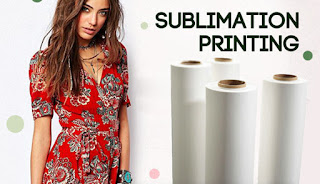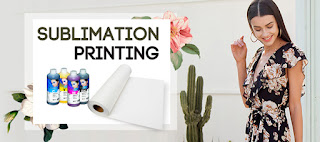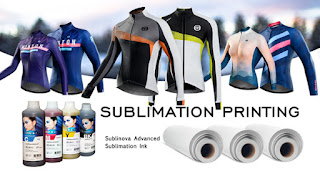Digital Decorating: Sublimation
Digital Decorating: Sublimation
Choosing a Sublimation Printer
Choosing the correct sublimation printer requires first determining what you want to produce.
Are you printing large designs on apparel? Smaller items, such as coasters, cellphone covers, flip flops, bag tags and plaques? Full-color graphics? High-definition photography? The answers to these questions will have a significant impact on your choice.
Other key factors to consider when choosing a sublimation printer are printing-field size, number of ink colors, and printing speed and cost.
Sublimation printers can be divided into the following categories based on media size and printing sophistication. Note that most printers do not print to the edge of the paper, thus the true printing field is slightly smaller than the media size.
Desktop Format: These are office-style units that print on individual sheets of paper and fit easily on any desk or table surface. They are ideal for startup operations due to their cost and ease of use. Paper sizes range from 8.5″ x 11″ to 13″ x 19″ (See “Desktop Format Media Sizes” for a full list of media sizes that can be used with this format.).
Narrow Format: These freestanding, commercial-grade units print onto rolls of paper ranging from 24-44 inches wide. They are ideal for growing businesses that need to generate larger images or higher-volume production.
Wide Format: These freestanding, industrial-grade units print onto rolls of paper measuring 44-104 inches wide. They are ideal for production facilities with specialized needs such as textile printing, trade-show banners, allover garments, etc.
Print-Field Size Tips
The general rule of thumb is to buy the smallest printer that can produce the largest image you need. For example, 12″ x 18″ designs are common with finished apparel; thus, a 13″ x 19″ printer would be ideal. A 24-inch freestanding printer also could work, but it wouldn’t be ideal if you didn’t routinely print designs up to 24 inches.
It’s safe to assume a ½-inch margin will be left on all sides of the media after printing. Thus, a 13″ x 19″ sheet probably has a maximum print field of 12″ x 18″.
The printer size also should be compatible with the heat-press size. To maximize production, the heat press should be slightly larger than the true maximum image-field size, typically 1-2 inches — at a minimum — on all four sides.
Another factor is printing multiple images simultaneously. Typically, six cellphone-cover images can fit on a single sheet of 8.5″ x 14″ paper. That number increases to 12 on a sheet of 13″ x 19″ paper.
Larger images take longer to print. In the production cycle, pressing typically is fixed at one minute, so printing time should be as close to one minute as possible. In some environments, it makes more sense to have multiple smaller printers working in tandem, which generates more images within the same timeframe than using one large printer.
Number of Ink Colors
Inkjet printers generate hundreds of thousands of output colors by mixing a select number of base ink colors. Most printers are four-color units with base ink colors of cyan, magenta, yellow and black (CMYK).
Other printer models are available with eight base colors. Examples of additional base colors include: light cyan, light magenta, red, orange, blue, etc. Eight-color systems present options for different ink sets to be used in different applications.
For example, if you want to focus on high-resolution photographs, buy an ink set specifically designed for delivering top-quality photographic images for sublimation. If you want to produce fluorescent colors, use an ink set designed for that application.
For most sublimators, a four-color printer will produce vibrant graphics, stunning colors and high-resolution photography. However, for fine art or photographic work — where subtle shades of color make a big difference — an eight-color printer may be more ideal.
Printing Speed
Specialy sublimation ink sets exist for operations focusing primarily on graphics and color matching.
Graphics often require expanded gamuts that deliver a more unique set of ink colors. For example, oranges and reds can be difficult to accurately match with standard CMYK printing. In addition, some blues and purples are on the outer fringes of the true CMYK gamut. Pantone colors also are tricky.
★About us★
We are sublimation paper professional supplier.Our company can supply any need about Epson printer, Epson ink, sublimation
transfer paper,sublimation ink, heat transfer paper for textile printing! www.feiyuepaper.com
★More info★
Website: www.feiyuepaper.com
Whatsapp/Wechat:008613776614520
Email:sales@feiyuepaper.com
Skype: li.sunny282
If you have any questions,call me,let's talk details.
★Follow Us★
Facebook: https://www.facebook.com/onestopsublimationsolutions/
Linkedin: https://www.linkedin.com/company/sublimation-skyimage/
Twitter: https://twitter.com/printerspare?lang=zh-cn
Pinterest: https://www.pinterest.com/sublistarprinterspare/
Google+: https://plus.google.com/+InkSublimationSunny/posts
Youtube: https://www.youtube.com/channel/UCvfhRcVPCNVm0YTdCCORPbw
Vk: https://vk.com/id324602723
Blogspot: https://sublimatestar.blogspot.com/
Choosing a Sublimation Printer
Choosing the correct sublimation printer requires first determining what you want to produce.
Are you printing large designs on apparel? Smaller items, such as coasters, cellphone covers, flip flops, bag tags and plaques? Full-color graphics? High-definition photography? The answers to these questions will have a significant impact on your choice.
Other key factors to consider when choosing a sublimation printer are printing-field size, number of ink colors, and printing speed and cost.
Sublimation printers can be divided into the following categories based on media size and printing sophistication. Note that most printers do not print to the edge of the paper, thus the true printing field is slightly smaller than the media size.
Desktop Format: These are office-style units that print on individual sheets of paper and fit easily on any desk or table surface. They are ideal for startup operations due to their cost and ease of use. Paper sizes range from 8.5″ x 11″ to 13″ x 19″ (See “Desktop Format Media Sizes” for a full list of media sizes that can be used with this format.).
Narrow Format: These freestanding, commercial-grade units print onto rolls of paper ranging from 24-44 inches wide. They are ideal for growing businesses that need to generate larger images or higher-volume production.
Wide Format: These freestanding, industrial-grade units print onto rolls of paper measuring 44-104 inches wide. They are ideal for production facilities with specialized needs such as textile printing, trade-show banners, allover garments, etc.
Print-Field Size Tips
The general rule of thumb is to buy the smallest printer that can produce the largest image you need. For example, 12″ x 18″ designs are common with finished apparel; thus, a 13″ x 19″ printer would be ideal. A 24-inch freestanding printer also could work, but it wouldn’t be ideal if you didn’t routinely print designs up to 24 inches.
It’s safe to assume a ½-inch margin will be left on all sides of the media after printing. Thus, a 13″ x 19″ sheet probably has a maximum print field of 12″ x 18″.
The printer size also should be compatible with the heat-press size. To maximize production, the heat press should be slightly larger than the true maximum image-field size, typically 1-2 inches — at a minimum — on all four sides.
Another factor is printing multiple images simultaneously. Typically, six cellphone-cover images can fit on a single sheet of 8.5″ x 14″ paper. That number increases to 12 on a sheet of 13″ x 19″ paper.
Larger images take longer to print. In the production cycle, pressing typically is fixed at one minute, so printing time should be as close to one minute as possible. In some environments, it makes more sense to have multiple smaller printers working in tandem, which generates more images within the same timeframe than using one large printer.
Number of Ink Colors
Inkjet printers generate hundreds of thousands of output colors by mixing a select number of base ink colors. Most printers are four-color units with base ink colors of cyan, magenta, yellow and black (CMYK).
Other printer models are available with eight base colors. Examples of additional base colors include: light cyan, light magenta, red, orange, blue, etc. Eight-color systems present options for different ink sets to be used in different applications.
For example, if you want to focus on high-resolution photographs, buy an ink set specifically designed for delivering top-quality photographic images for sublimation. If you want to produce fluorescent colors, use an ink set designed for that application.
For most sublimators, a four-color printer will produce vibrant graphics, stunning colors and high-resolution photography. However, for fine art or photographic work — where subtle shades of color make a big difference — an eight-color printer may be more ideal.
Printing Speed
Specialy sublimation ink sets exist for operations focusing primarily on graphics and color matching.
Graphics often require expanded gamuts that deliver a more unique set of ink colors. For example, oranges and reds can be difficult to accurately match with standard CMYK printing. In addition, some blues and purples are on the outer fringes of the true CMYK gamut. Pantone colors also are tricky.
★About us★
We are sublimation paper professional supplier.Our company can supply any need about Epson printer, Epson ink, sublimation
transfer paper,sublimation ink, heat transfer paper for textile printing! www.feiyuepaper.com
★More info★
Website: www.feiyuepaper.com
Whatsapp/Wechat:008613776614520
Email:sales@feiyuepaper.com
Skype: li.sunny282
If you have any questions,call me,let's talk details.
★Follow Us★
Facebook: https://www.facebook.com/onestopsublimationsolutions/
Linkedin: https://www.linkedin.com/company/sublimation-skyimage/
Twitter: https://twitter.com/printerspare?lang=zh-cn
Pinterest: https://www.pinterest.com/sublistarprinterspare/
Google+: https://plus.google.com/+InkSublimationSunny/posts
Youtube: https://www.youtube.com/channel/UCvfhRcVPCNVm0YTdCCORPbw
Vk: https://vk.com/id324602723
Blogspot: https://sublimatestar.blogspot.com/







评论
发表评论